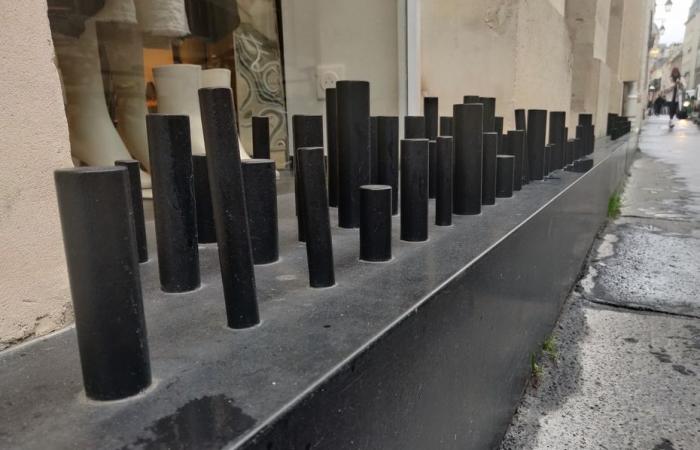
Peaks, bars, grilles, rocks… The Abbé Pierre Foundation denounces the proliferation of measures designed to combat the presence of homeless people in public spaces or in front of shop windows and banks. She is organizing a new edition of the Pics d'or, a satirical ceremony against this phenomenon.
Company
From daily life to major issues, discover the subjects that make up local society, such as justice, education, health and family.
France Télévisions uses your email address to send you the “Society” newsletter. You can unsubscribe at any time via the link at the bottom of this newsletter. Our privacy policy
Four Parisian anti-homeless devices have the honor of being nominated for the 2024 Pics d'or: pointed picks installed in front of a sign at 40 rue de Sévigné, in the 3rd arrondissement, in the “unscrupulous” category; bars erected in front of a school at 6 allée Darius Milhaud, in the 19th arrondissement, in the “imposter” category; a plaque discreetly screwed in front of a window at 11 rue Hautefeuille, in the 6th arrondissement, in the category “neither seen nor known”; and finally walls built under arches at 154 boulevard de la Villette, in the 19th arrondissement, for the public prize.
For its 3rd edition organized this Monday evening at the Théâtre de l'Atelier by the Abbé Pierre Foundation, the ceremony continues to “denounce hostile installations which prevent the most deprived people from sheltering or taking a little rest in public spaces, while making them invisible and pushing them ever further away from city centers“.
During the event, which aims to “'reward' in a satirical manner the anti-homeless measures which continue to multiply in France“, comedians Blanche Gardin, Amelle Chahbi and Guillaume Meurice are notably invited to present the prizes to the winners.
In front of one of the addresses in the capital selected for this edition, a saleswoman explains that the device “comes from the owners of the building, not the store“. “It's really not nice, and it's not at all useful. Here people don't sit on the edge of the shops, it's empty. And what's more, it's not practical for us to clean“, she reacts.
In the neighborhood, opinions differ. “It's serious, the homeless cannot 'live', they have no place to stay. It's to make sure it's clean, that there's no one on the street. So that we don't realize it“, laments Sasha. “And the State does not act. It's discrimination against the poor“, adds Shirel.
Bars erected in front of a school in the 19th arrondissement, named in the “imposter” category.
•
© Abbé Pierre Foundation
“On the one hand, I find it normal that we don't want people to sleep in front of shops and get dirty. But in the meantime it's sad that it's come to this, to prevent them from sleeping in certain places, and it shows that there are a lot of people on the streets. This is absurd, people shouldn't sleep outside. It's not normal that there are so many homeless people“, estimated for the Elisa part.
“I am for it. I admit that I don't like seeing homeless people in front of stores, it's true. Honestly, it gives a bad image. Otherwise it quickly becomes a pigsty, everything is disgusting. I don't blame the homeless. It's a question of hygiene, cleanliness, safety. There should be more places dedicated to the homeless, but I am not in favor of them remaining on public roads“, defends Béatrice.
For its part, the Abbé Pierre Foundation “denounces the choices which increasingly lead to making the city, the street, an inhospitable and dangerous place for the people who are forced there“, pointing”these inhumane devices“. Noria Derdek, legal manager for the foundation, recalls that “the main victims are homeless people. These ledges can allow them to rest after a day of wandering and possibly to stay there for a long time, given that they have no private space, no warm sofa.“
“This is not a recent phenomenon, we were already seeing this type of device in the 1990s, she specifies. But these are processes that are increasingly used in public and private spaces, and on benches as well. And they are becoming more and more aggressive. And the devices overlap: we already put stones, then grids, then blocks… We see a certain relentlessness. Some devices can be dangerous, you can hurt yourself on a spike if you trip while looking at your phone for example. This is also a way to have them removed by asking the municipality. Sometimes there are blades, very sharp, and even barbed wire.“
A plaque in front of a window in the 6th arrondissement, named in the “neither seen nor known” category.
•
© Abbé Pierre Foundation
Camille Gardesse, sociologist at the Paris School of Urban Planning, underlines “a logic of dissuasion and repression of the occupation of public space by the most precarious“, with “systemic dimension“. “It is really a logic of planning urban space, to prevent uses deemed undesirable by homeless people: shelter, sleeping, deploying means of subsistence such as begging. Some devices are more discreet than others and resemble street furniture“, she explains.
The Abbé Pierre Foundation, which “urges public authorities to act“, also calls on “all citizens” to fight against these devices by reporting them on the ceremony site, and by “alerting local elected officials” notably “so that they are attentive when public contracts are awarded” et “so that they put in place reporting measures for owners and traders when devices are installed in private buildings“.
The foundation also calls for producing more social housing by allocating it “giving priority to the most disadvantaged people“, has “mobilize the private stock to complete the affordable housing offer“, to ensure”dignified reception of migrants“, and to put an end to the “rental evictions without solution“.
With Didier Morel and Gaëlle Darengosse.





